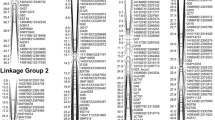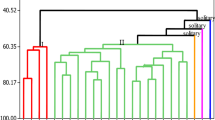Abstract
Vernonia galamensis is a wild plant from the family Asteraceae which is endemic to East Africa and has the potential to become a new oil crop for industrial uses. Its seed oil is rich in vernolic acid, a fatty acid of high interest for oleochemical applications. However, a breeding program for Vernonia galamensis cultivars with high seed and oil yields requires knowledge about the genetic variability of traits that influence seed and oil production. This study was undertaken to examine phenotypic and genotypic variability, broad-sense heritability, genetic advance under selection and interrelationships of agronomic and seed quality traits. A total of 122 Vernonia accessions, 115 collected from different regions of Ethiopia and seven introduced, were grown at two locations in Ethiopia (Alemaya and Babile), in 2001/2002 and were analyzed for 20 traits including phenology, yield, yield components, and seed quality with special emphasis on fatty acid composition. The collections exhibited significant variation for all traits except for days to emergence. Genotypes and locations interacted significantly (P≤ 0.01) for all traits. Broad-sense heritability estimates ranged from 11% (for days to emergence) up to 79% (for days to maturity). Expected genetic advance was between 1.3% (for days to emergence) and 44.8% (for seed oil yield). Genetic correlation analysis revealed that seed yield per plant is highly and positively correlated with seed weight and head number; highly significant and negative correlations (r = −0.59, −0.82, −0.85, and −0.89) were found between vernolic acid and palmitic, stearic, oleic, and linoleic acid, respectively. Highly significant positive correlations (r = 0.55, 0.44, and 0.36) were observed between vernolic acid and oil content, meal protein content and seed oil yield, respectively. Path-coefficient analysis indicated seed weight and secondary head number to be the most important components of seed yield per plant. Vernolic acid, oleic acid and linoleic acid had positive direct effects and stearic acid had a negative direct effect on oil content. The direct positive effect of oleic acid on oil content was, however, compensated by the negative indirect effects of stearic and vernolic acid resulting in a negative correlation (r = −0.60) between oleic acid and oil content. These observations will support the selection of accessions with high seed and oil yield, high meal protein contents, and high vernolic acid content.
Similar content being viewed by others
References
Allard, R.W., 1999. Principles of Plant Breeding, 2nd edn. New York, Wiley.
Angelini, L.G., E. Moscheni, G. Clonna & P. Belloni, 1997. Variation in agronomic characteristics and seed oil composition of new oilseed crops in central Italy. Ind Crops Prod 6: 313–323.
Baye, T. & H.C. Becker, 2004a. Exploration of Vernonia galamensis in Ethiopia, and variation in fatty acid composition of seed oil. Genet Res Crop Evol (in press).
Baye, T. & H.C. Becker, 2004b. Analyzing seed weight, fatty acid composition, oil, and protein contents in Vernonia galamensis germplasm by Near Infrared Reflectance Spectroscopy. J Am Oil Chem Soc 81: 641–645.
Baye, T., H.C. Becker & S.V. Witzke-Ehbrecht, 2004. Vernonia galamensis, natural source of epoxy oil: Variation in fatty acid composition of seed and leaf lipids. Ind Crops Prod (in press).
Baye, T., H. Kebede & K. Belete, 2001. Agronomic evaluation of Vernonia galamensis germplasm collected from Eastern Ethiopia. Ind Crops Prod 14: 179–190.
Baye, T., 1996. Characterization and evaluation of Vernonia galamenis var. ethiopica germplasm collected from eastern Ethiopia. M.Sc thesis, Alemaya University of Agriculture, Dire Dawa, Ethiopia.
Earle, F.R., 1970. Epoxy oils from plant seeds. J Am Oil Chem Soc 47: 510–513.
Falconer, D.S., 1989. Introduction to Quantitative Genetics. 3rd edn., Longman, London.
Fehr, W.R., 1987. Principles of Cultivar Development, Vol. I., MacMillan, New York.
Fernández-Martínez, J., M. del Rio & A. de Haro, 1993. Survey of safflower (Carthamus tinctorius L.) germplasm for variants in fatty acid composition and other seed characters. Euphytica 69: 115–122.
Gilbert, M.G., 1986. Notes on eastern Africa Vernonieae (Compositae). IV. A revision of the Vernonia galamensis complex. Kew Bulletin 41: 19–35.
Hill, J., H.C. Becker & P.M.A. Tigerstedt, 1998. Quantitative and Ecological Aspects of Plant Breeding. Chapman and Hall, London.
Holland, J.B., W.E. Nyquist & C.T. Cervantes-Martinez, 2002. Estimation and interpreting heritability for plant breeding: An update. Plant Breed Rev 22: 9–112.
Johnson, H.W., H.F. Robinson & R.E. Comstock, 1955. Estimates of genetic and environmental variability in soybeans. Agron J 47: 314–318.
Lynch, M. & B. Walsh, 1998. Genetics and analysis of quantitative traits, Sinauer.
Mandal, S., S. Yadav, R. Singh, G. Begum, P. Suneja & M. Singh, 2002. Correlation studies on oil content and fatty acid profile of some cruciferous species. Genet Resour Crop Evol 49: 551– 556.
Mharapara, I.M. & F.T. Mugabe, 1991. Development of Vernonia in Zimbabwe, Chiredzi Research Station report. Unpublished.
Möllers, C. & A. Schierholt, 2002. Genetic variation of palmitate and oil content in a winter oilseed rape double haploid population segregating for oleate content. Crop Sci 42: 379–384.
Nyquist, W.E., 1991. Estimation of heritability and prediction of selection response in plant populations. Crit Rev Plant Sci 10: 235–322.
Perdue, R.E., 1988. Systematic botany in the development of Vernonia galamensis as a new industrial oilseed crop for the semi-arid tropics. Symbollae Botanicae Uppsaliensis 28: 125–135.
Perdue, R.E., K.D. Carlson & M.G. Gilbert, 1986. Vernonia galamensis, potential new crop source of epoxy acid. Econ Bot 40: 54–68.
Rasmuson, M., 2002. The genotype-phenotype link. Hereditas 136: 1–6.
Robinson, H., 1999. Revisions in paleotropical Vernonieae (Asteraceae). Proc Bio Soc Wash 112: 220–246.
Seiler, G.J. & M.E. Brothers, 1999. Oil concentration and fatty acid composition of achenes of Helianthus species (Asteraceae) from Canada. Econ Bot 53: 273–280.
Scheiner, S.M., R.J. Mitchell & H.S. Callahan, 2000. Using path analysis to measure natural selection. J Evol Biol 13: 423–433.
Shipley, B., 1997. Exploratory path analysis with applications in ecology and evolution. Am Nat 149: 1113–1138.
Stiles, D., 1988. Arid land plants for economic development and desertification control. Desertification Control Bulletin 17: 18–21.
Tamirie, H., 1973. Summary results of soil research report. Alemaya University of Agriculture, Dire Dawa, Ethiopia.
Thompson, A.E., D.A. Dierg & R. Kleiman, 1994. Characterization of Vernonia galamensis germplasm for seed oil content, fatty acid composition, seed weight, and chromosome number. Ind Crops Prod 2: 299–305.
Utz, H.F., 1994. Plabstat, ein Computerprogram für statistische Analysen von Pflanzenzüchtungs-experimenten. Universität, Hohenheim, Germany.
Weiss, E.A., 1983. Oilseed Crops. Tropical Series, pp. 603, Longman Inc. Leonard Hill Books, New York.
Wricke, G. & W.E. Weber, 1986. Quantitative Genetics and Selection in Plant Breeding. Walter de Gruyter & Co., Berlin.
Zhao, J., 2002. QTLs for oil content and their relationships to other agronomic traits in an European × Chinese oilseed rape population, Doctoral Dissertation, University of Göttingen, Germany, pp. 60–74, http://webdoc.sub.gwdg.de/diss/2002/zhao_jianyi/index.html.
Author information
Authors and Affiliations
Corresponding author
Rights and permissions
About this article
Cite this article
Baye, T., Becker, H.C. Genetic variability and interrelationship of traits in the industrial oil crop Vernonia galamensis . Euphytica 142, 119–129 (2005). https://doi.org/10.1007/s10681-005-1042-4
Received:
Accepted:
Issue Date:
DOI: https://doi.org/10.1007/s10681-005-1042-4




